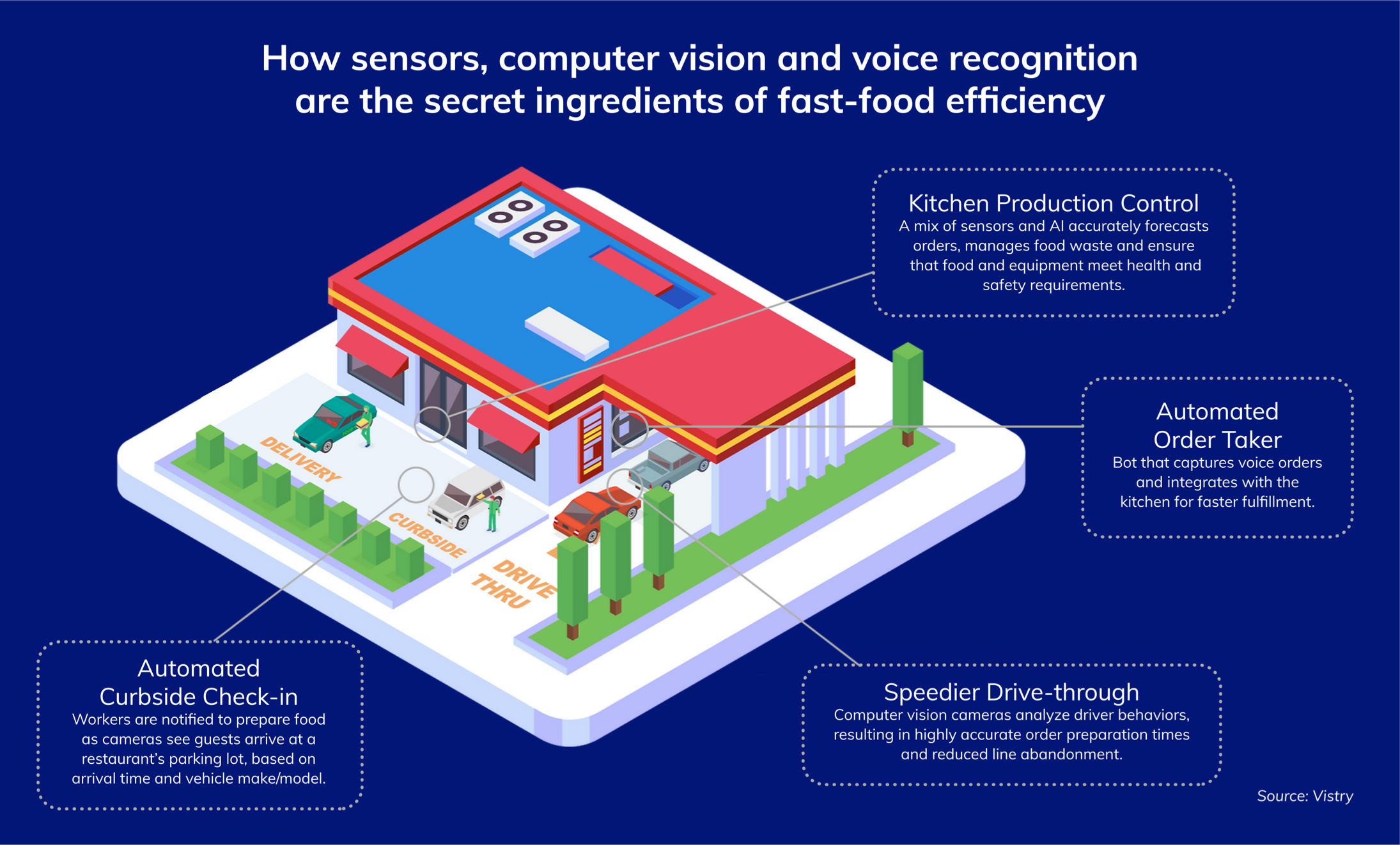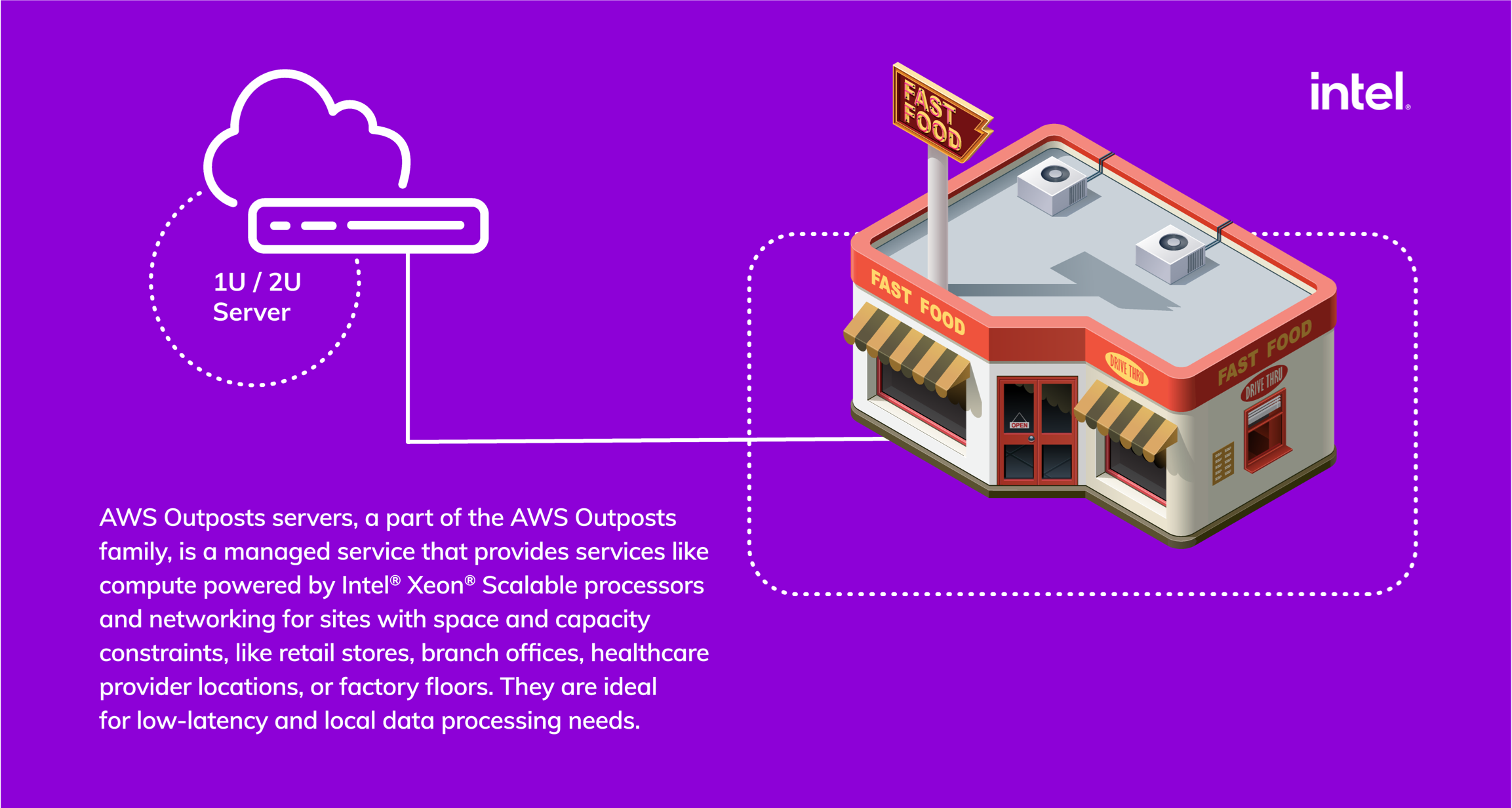Hamburgers and the High-Tech Future of Restaurants
Using AWS to make fast-food restaurants more efficient and, yes, faster.
When fast food works, it’s a perfect model of instant gratification: A hungry customer pulls into a drive-through and places an order, then moments later the aroma of french fries wafts through the car.
But when it doesn’t work – hiccups on the prep line, a long line of cars waiting their turn at the speakerbox – food gets cold or goes into the trash, while frustrated drivers navigate elsewhere in search of not-so-instant gratification. All that adds up to losses for restaurant owners.
AWS Outposts helps restaurant kitchens be more efficient with advanced technologies to turn each step of the burger-making process into data points that can be monitored, analyzed and managed in real time. AWS Outposts servers, a fully managed solution, provide infrastructure, services, APIs, and tools deployed on-premises at locations that are space- and capacity-constrained, like a fast-food restaurant, allowing decisions like order-processing and operations to be made locally and quickly.
And when Outposts servers pair with Vistry, a restaurant-based analytics platform and AWS Outposts ISV partner, they can easily look at the inefficiencies common to fast-food and fast-casual dining like a computer would. Atif Kureishy, Vistry’s CEO, describes this process as seeing beyond sheer volume of cars in a drive-through line to a level of detail that – when customer permissions are granted – can associate your car’s license plate with your typical order at that time of day, signaling the kitchen to begin preparing it as you pull into the parking lot. Kureishy compares burger components waiting to be stacked and wrapped to car parts conveying toward roboticized arms for bolting in place.
It’s no accident this vision of automation sounds more at home in a smart factory than a restaurant. “From a computer-vision perspective, these are different objects,” he says. “But in terms of sequencing and making sense of them, it’s very similar. The idea is to use machine learning to predict how much of what food to make, when, and for whom.”
And if that appears to flout the idea of our food being made with love – well, Kureishy points out customers love the speed and accuracy that AWS Outposts servers and sensor-powered kitchen automation supports, while owners love the boost to their bottom line.
“With the dependability and scalability of AWS Outposts tooling and infrastructure services, we don’t have to build our own solution. That means we can spend 99 percent of our time working with the digital and drive-through leaders in the restaurant’s corporate office to say, ‘I’m going to improve your drive-through throughput by one percent,’” Kureishy says. “‘And if I improve it by one percent, that’s equivalent to millions of dollars across the entire chain of restaurants.’”

Bringing the cloud closer to a restaurant improves both sides of the fast-food counter
Analyzing customer traffic and syncing it to order histories – while also reducing waste by sensing food temperatures relative to food safety – all requires data-processing power where every millisecond matters. AWS Outposts servers and Vistry are one of many ingredients making high-tech kitchens of the future possible today.
“One of the things that’s most exciting here is a blend of complementing strengths,” Tatiana Cooke, Principal Product Manager of AWS Outposts, says of the AWS and Vistry partnership. “Vistry has the restaurant-specific expertise of knowing what kind of sensors, what kind of data ingestion, what kind of operations and process flows are most meaningful. Then we can say, let us take care of the undifferentiated heavy lifting – the underlying infrastructure, the compute, the hardware, all those tools and all that monitoring and management.”

Beyond computer vision and the predictive analyses it unlocks about restaurant customers, Vistry has also created hybrid cloud-powered bot technology that “takes” orders by analyzing human speech with precision that rivals – or bests – what humans can hear and then enters the orders into the restaurant’s system.
In some cases, speech-recognition applications can require 100 times the compute power of text-based analysis, making it even more critical that AI applications like these can remain on-premises for a restaurant or retailer by running on AWS Outposts servers.
“That’s where we can really create value for customers,” says Cooke. “It’s by bringing data from IoT sensors, cameras, and audio equipment together and synthesizing that in one system to get better insights.”

Out of the kitchen: AWS Outposts helps other industries where seconds count and data needs a fixed address
Restaurants aren’t the only rapidly-transforming environments experimenting with AI for efficiency. From the monitoring of manufacturing assembly lines to the regulatory needs of financial services and online betting, many industries have the need for cloud compute power on-site.
“Having the power of AWS tools and our ecosystem allows customers to move really fast in a changing operating environment,” Cooke says. “If you think about organizations running in the cloud today, they’re operating hundreds of thousands of cloud-based instances all across the globe. Our goal with Outposts is to deliver the benefit of orchestration tools for all those big workloads that just happen to be spread across a lot of little sites.”
Amazon Web Services (AWS) hybrid solutions seamlessly extend the same AWS infrastructure, Intel® powered compute, services and tools in the cloud, on-premises, and at edge locations. Intel® processors provide the foundation of many hybrid and edge computing services deployed on AWS. Amazon Elastic Compute Cloud (Amazon EC2) instances powered by Intel® Xeon® Scalable processors have the largest breadth, global reach, and availability of compute instances across AWS geographies. AWS and Intel’s® 15-year relationship is continuously dedicated to developing, building, and supporting services that are designed to manage cost and complexity, accelerate business outcomes, and scale to meet current and future computing requirements.


